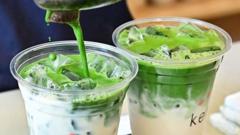Matcha, a finely ground powdered green tea from Japan, is enjoying a global renaissance. Popular among foodies and health-conscious consumers, this vibrant green tea has found its way into a plethora of products, from trendy lattes at major coffee chains to unique desserts at specialty stores. The driving force behind this matcha wave can be squarely attributed to the influence of social media platforms, where the hashtag "MatchaTok" has accumulated millions of views, showcasing everything from brewing techniques to matcha-infused recipes.
The recent spike in matcha demand aligns with Japan's tourism recovery post-pandemic, as the weakened yen has encouraged travelers to explore the country and its culinary offerings. However, this burgeoning interest comes at a time when matcha supplies are critically low. Lauren Purvis, a tea importer based in the US, noted her clients typically expect one-month supplies of matcha to vanish within days. Some establishments are now ordering as much as a kilogram of matcha daily to meet consumer appetites.
Simultaneously, climate factors and international trade shifts are putting immense pressure on matcha production. The unique nature of matcha—made from shade-grown tencha leaves that undergo meticulous processing—demands stable weather and sufficient labor. Unfortunately, soaring temperatures and a declining number of farmers in Japan have severely limited harvests, particularly in region known for its matcha. The scarcity has led retailers, especially in matcha-rich Kyoto, to implement purchase limits to combat stockpiling by tourists.
As demand skyrockets, prices are correspondingly climbing, with some businesses reporting a price increase of up to 30%. Despite acknowledging the good fortune of heightened interest in matcha, insiders in the industry express concern over the increased realization of its financial worth, particularly when high-quality matcha gets misused in cooking where it loses its unique flavors and potential.
To counteract the hoarding mentality, tea advocates are promoting the use of lower-grade matcha, which is more readily available and intended for culinary use. This encouragement echoes sentiments from the Global Japanese Tea Association, which seeks to foster respect for traditional tea practices while informing consumers of the impact their choices may have on producers.
Further complicating matters, the impending U.S. tariffs on Japanese matcha are poised to add further strain to the supply chain. Trade deal negotiations have resulted in a 15% import tax on Japanese goods, provoking concern among matcha distributors. Nonetheless, some industry experts remain optimistic, suggesting that demand may stabilize in the coming years, allowing the market to realign prices.
In the panorama of culinary delights and health advantages associated with matcha, the current crisis emphasizes the need for mindful consumption and sustainable practices to ensure that this cherished tea remains cherished, not hoarded.





















